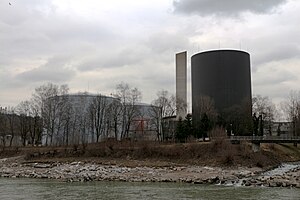Salzburg Nord thermal power station
| Salzburg Nord thermal power station | |||
|---|---|---|---|
| Salzburg Nord thermal power station | |||
| location | |||
|
|
|||
| Coordinates | 47 ° 49 '37 " N , 13 ° 2' 0" E | ||
| country |
|
||
| Waters | Salzach | ||
| Data | |||
| Type | Thermal power plant / combined heat and power with heat buffer | ||
| Primary energy | Fossil energy | ||
| fuel | Heavy fuel oil , town gas | ||
| power | 49.5 MW thermal, 13.5 MW electrical |
||
| operator | Salzburg AG | ||
| Project start | 1992 | ||
| Start of operations | 1995 | ||
| turbine | Steam turbine | ||
| Firing | Gas-oil dual burner system (Block I), heavy oil boiler (Block II) | ||
| Chimney height | 70 m | ||
| Energy fed in oA | 31.085 million kWh of electricity, 158.53 million kWh of heat GWh | ||
The Salzburg Nord combined heat and power plant is a district heating power plant and a power plant for generating electricity in Salzburg . The cogeneration plant is in the Itzling - West district , directly on the Salzach and the West Autobahn . It is characterized by a modern architectural design that is well worth seeing.
History and architecture
In 1972 the then Stadtwerke Salzburg (today Salzburg AG ) built another district heating plant between Alterbach , Salzach and Autobahn, north of the Wasserfeldsiedlung , to supply the developing district of Lehen and Itzling. A third boiler was retrofitted as early as 1974 due to the high demand.
At the beginning of the 1990s, the plant no longer met the emission protection guidelines and was rebuilt in two blocks from 1992–1995. The design comes from the Swiss architecture firm Bétrix & Consolascio (Marie-Claude Bétrix, Eraldo Consolascio) with Eric Maier, who had already designed the substation Mitte (built 1989–1995) and West (1997–1999), and then the controversial central heating plant .
The Block I act, although moderately on a rectangular floor plan and in the body, entirely organic , with curved lines in the first line. The 70 meter high, free-standing chimney has a conical, square floor plan and a triangular closure. The material is exposed concrete for the body, raw welded Nirosta steel for the front facing facade and the roof, which result in a slightly irregular, shimmering surface and a disintegrated cubature. The interior of the turbine hall impresses with its clear recognizability of the form structures of the building concept. The building presents itself as a transition from strict Brutalism ( French brut , raw ') to postmodern freedom of expression is.
The Block II , left (salzach sided) next to it, is the conversion of the old boiler house from 1967. It is a simple cube with roof cowls, Eternit boarding at the base, the broad band of skylights amethyst-colored.
The ensemble is complemented by the smaller company building, two cylindrical, bright pale turquoise oil tanks about 20 m high and 40 m in diameter, and since 2011 a 44 m high, 29 m diameter, completely evenly cylindrical and deep black heat storage unit.
The ensemble is a model example of modern industrial architecture , and its location on the West Autobahn makes it a landmark of the outskirts, which contrasts and harmonizes with the historical center (UNESCO World Heritage Site): shapes and colors can be found in the magnificent baroque buildings with their towers , Domes, and patinated copper roofs again.
Technical equipment and operation
The power plant is equipped with a combined heat and power system. It has a thermal output of 49.5 MW and an electrical output of 13.5 MW ( bottleneck output ); the annual generation is 158.53 million kWh of heat and 31.085 million kWh of electricity.
The heavy oil - natural gas dual burner system in Block I (built in 2008) has a fuel heat output of 67,000 kW and drives a base load steam turbine (1993). The boiler system in Block II has an output of 33,000 kW and only functions as a peak load generator.
The water buffer storage has a usable volume of 27,000 m³, a heat content (full) of 1.1 GWh, and a maximum loading and unloading capacity of 60 MW, about as much as the entire power plant delivers under full operation.
Since the integration of the waste heat rail south (AWS) and the biomass heating power plant in Siezenheim , the power plant no longer needs to be used for the city's summer supply, and then primarily buffers renewable energy and waste heat.
proof
- Salzburg AG for energy, traffic and telecommunication: Thermal power plants and heating plants - heat and electricity. Folder, undated, Heizkraftwerk Salzburg Mitte , p. 5, fig. P. 2, flue gas cleaning - warmth with vision , p. 6 ( pdf , salzburg-ag.at)
- Salzburg Nord thermal power station ; Heat storage HKW Nord , salzburg-ag.at → systems
- Combined heat and power plant north / block I ; Thermal power station North / Block II , entries in nextroom.at
- Industry and commerce: 09 Heizkraftwerk Nord / Block I ; 10 Nord / Block II thermal power station , City of Salzburg, Architekturforum, archtour-stadt-salzburg.at
- Central heating plant . In: Salzburger Nachrichten : Salzburgwiki .
-
↑ a b Thermal storage heating power plant north . In: Salzburger Nachrichten: Salzburgwiki .;
44-meter giant boiler for the city of Salzburg , sbg.orf.at, August 15, 2011;
There are also technical reasons for the coloring, passive heat protection for the tanks, passive solar collector for the buffer.

